#Humanoid Robots Market Size
Text
Humanoid Robot Market - Forecast 2021-2026
Global
Humanoid Robot Market
is forecast to reach $3.0 billion by 2026, estimated to grow at a CAGR of 30.9% from 2021 to 2026. Humanoid Robot Market is driven by the increasing demand of safety and comfort, of the human beings, due to advancement in technologies. The humanoid collaborative robot performs tedious and strenuous tasks through electronic design automation and artificial intelligence (particularly reinforcement learning), which are avoided by humans, this is going to provide huge growth to humanoid robot market. The use of Humanoid robots in supportive patient care as gynoids, social robots and bipedal lcoomotion based patient care robots, is going to provide huge growth to humanoid robot market in healthcare. Additionally, introduction of advance technology such as
artificial intelligence
, tactile sensing and visual perception is going to provide the self-learning capabilities to humanoid robots, which are going to boost the humanoid robot market.
Report Coverage
The report:
“Humanoid Robot Market Forecast (2021-2026)”
, by IndustryARC, covers an in-depth analysis of the following segments of the Humanoid Robot Market.
By Motion:
Biped, Wheeled Drive and Others.
By Component:
Hardware, Software.
By Application:
Education, Infotainment, Research, Personal Assistance, Search and Rescue, Corporate, Hospitality, Healthcare, Residential, Marine and Others.
By Geography:
North America (U.S., Canada and Mexico); Europe (U.K., Germany, Italy, France,Spain, Russia, Rest of Europe); APAC (China, Japan, South Korea, India, Australia, Rest of APAC); South America (Brazil, Argentina, Rest of South Americas); RoW (Middle East & Africa).
Request Sample
Key Takeaways
Humanoid robot market is driven by the increasing demand of safety and comfort. The humanoid robot can perform various tasks which are dangerous for humans, which is going to boost the humanoid robot market.
Introduction of advance technology such as artificial intelligence (AI) is going to provide self learning capabilities to humanoid robot. This is going to boost humanoid robot market during the forecast period.
Humanoid robot market is dominated by APAC region followed by North America during the forecast period. The presence of major humanoid manufacturing countries such as China Japan and others. Moreover Increasing deployment of humanoid robot in healthcare and education is going to provide huge growth to humanoid robot market in APAC region.
Humanoid Robot Market Segment Analysis – By Motion
Biped motion type humanoid robots are estimated to hold the major share in humanoid robot market during the forecast period. The growing demand of biped motion type humanoid robots in industry as well as academia, for various purposes, is going to boost the humanoid robot market. The biped motion type (BMT) humanoids robot can easily climb up stairs and avoid obstacles on the floor. The BMT humanoid robots are widely used for advertisement, research platform, publicity campaigns, house-hold work and others, which is going to provide huge growth to humanoid robot market.
Humanoid Robot Market Segment Analysis – By Application
Healthcare followed by education is estimated to hold the major share in humanoid robots of 21% in 2020. The introduction of surgical humanoid robot is going to provide huge growth to humanoid robot in healthcare. Additionally, humanoid robots can also be deployed for disease management, pediatric healthcare assistant, physical therapy and others. With the growing demand of E-learning the demand of humanoid robot is also increasing, the humanoids are widely used for the role of teaching assistant and games partner for children. Additionally with the introduction artificial intelligence (AI) in humanoid robots is going to provide huge growth to humanoid robot market in the research field.
Humanoid Robot Market Segment Analysis – By Geography
APAC followed by North America region is expected to dominate the humanoid robot market during the forecast period 2021-2026 with a share of 39% in 2020. The countries present in APAC region such as Japan, China others, are one of largest humanoid robot manufacturing countries. The humanoid robot(HM)are deployed in various tasks such as advertisement, teaching assistant and others, which is going to provide huge growth to humanoid robot market in this region. Moreover countries are such as China, Japan are planning to deploy humanoid in healthcare and education due to covid-19 outbreak, which is going to boost HM market in this region. In North America region the presence of key companies such as Canonical Group, Diligent Robotics, Boston Dynamics and others, is going to provide humanoid robot market. Additionally with the introduction of artificial intelligence (AI) and increasing the demand of humanoid in military and healthcare is going to boost HM market in North America region.
Inquiry Before Buying
Humanoid Robot Market Drivers
Increasing Demand of Safety and Comfort
The humanoid robot can perform various tasks which are dangerous to human such as exposure to harmful gases in various industries. Humanoid robot can also be deployed at the time of natural disasters, pandemic diseases such as covid-19 and others, which is going to provide huge growth to humanoid robot market. Additionally the humanoid robots can be deployed in battle field and in jobs in which human worker don’t want to do, which is going to boost the humanoid robot market.
Introduction of Advance Technology
The introduction of smart technologies such as artificial intelligence (AI) and Internet of things (IoT) is going boost the humanoid robot market. With the use AI humanoid robot can educate themselves by observing and analyzing data using different sensors. Whereas IoT enables humanoid robot to stay connected and transfer data from remote or far distance. Additionally by the application of theses advance technology the demand of humanoid robot is going to increase in various industry verticals, which is going to boost humanoid robot market.
Humanoid Robot Market Challenges
High Power Consumption
The humanoid robots are manufactured by using various types of sensors and other components. The high power consumption by the components is acting as hindrance in the growth of humanoid robot. Additionally the biped humanoid robots require more energy as compared to others, due to addition of more sensors and components, which is restring the growth humanoid robot.
Buy Now
Humanoid Robot Market Landscape
Launches, Innovations and R&D activities are key strategies adopted by players in the humanoid robot market. Humanoid Robot Market is expected to be dominated by major companies such as Toyota, Hitachi, Honda, ISRO, Boston Dynamics and Others.
Innovation/LaunchesIn March 2020, Hitachi, announced to launch a full-scale commercial operations with Excellent Mobility and Interactive Existance as Workmate (EMIEW) communication robot. The robot is primarily for the offices, hospitals and care facilities, which are going to boost the humanoid robot market.
In January 2020, The Indian Space Research Organization (ISRO) is announced to launch Vyommitra, a semi humanoid robot to space. This robot doesn’t require any space suit and is going to help by sending warning according to the changes in cabin environments. This is going to provide boost the humanoid robot market in the field of Space
Related Reports
Construction Robot Market - Forecast(2021 - 2026)
Report Code: ESR 14251
Industrial Robotics Market - Forecast(2021 - 2026)
Report Code: AIR 0032
For more Automation and Instrumentation related reports, please
click here
0 notes
Text
TFP and Alien Character Design
My introduction to the Transformers franchise were bayformers (accidentally) and Transformers: Prime (on purpose), and given their designs it took me a while to come around for the classic (and more marketable) boxy designs. I’d like to specifically take a moment to appreciate TFP, since I feel it sells the “alien robots” part the best.
I absolutely love how TFP’s artists have taken liberties and given each bot their own, distinctive look instead of sticking to a formula (aka a toy mould). I especially adore how, while clearly humanoid and analogous to us, they manage to look very alien.
Every bot has a humanoid form with a head, a torso, and four limbs, two legs and two hands to be precise. Predacons and Insecticons aside, there are many more subtle variations that make the bots look distinctly less human.
One obvious point is the lack of noses on any of them, and I feel like it’s a bit controversial to say that’s a good choice. I appreciate it, because while it changes the profile only a little, it highlights that the bots don’t need a nose, not for breathing or for forming sounds. I know the “making sounds to talk” part is undermined by the fact that they have mouths that move to their speech, but I see that being more due to keeping them pleasant to watch, especially since “mouth doesn’t match the sounds” is generally understood more as poor or lazy animation rather than a decision on character design and storytelling.
Also mouth or even eyes are not necessary for the bots, not for speaking or seeing. Both Soundwave and Shockwave have designs where their heads don’t (at least obviously) have mouths or eyes. Soundwave’s visor could hide a face, but we know for sure from Shockwave’s design that it’s not a certainity for their species. Soundwave’s design even calls to question the rule of four limbs, because we don’t know how his tentacles function: Are they limbs he was born with? Are they some sort of a device or a modification installed on his natural frame? Could they be extra arms instead of data cables? Could every bot theoretically have extra limbs installed?
Airachnid also has multiple limbs at her disposal, in her spider form. Interestingly, she seems to have two alt forms, the spider one and the helicopter, while her bot form also has two arms and two legs. However, she seems to be an outlier, considering that she has been “inspired” by other alien species on her galactic travels (her own words), and the reaction from other bots, for example Breakdown’s comment “the extra arms freak me out”. What Airachnid and Soundwave share is that their “extra limbs” are different from their arms and legs, which might mean that they are more like the wheels or wings of the alt forms other bots have.
Shockwave’s head is pretty obviously inspired by a security camera, which supports his uncanny, emotionless image. He has one eye and not much else, being an example of bots forming speech entirely with a device/organ, the voice box, in their throat (see also: Bumblebee’s mutism). In fact, Shockwave’s head is so small and strangely structured around the single eye that it makes me question if his CPU is somewhere else on his body. Once again, this opens possibilities to how Cybertronians function: The head doesn’t necessarily carry as much importance to them as it does to humans.
Various smaller details in the designs deserve a shoutout as well: The different shapes of hands and fingers, made of different materials and varying proportions. There are different kinds of eyes, and not varying only in colour, but also shape, size, quantity, and if they have a visible iris and pupil or not. The bot and vehicle modes are clearly linked, largely corresponding with the shape and weight of the vehicle mode, and parts of machienery visible.
Given all of the above, all sorts of mods and changes that would be either very difficult or impossible for human body, might not be so to Cybetronians. Their humanoid shape seems much more incidental when youconsider all the alien aspects worked into the designs and the story.
51 notes
·
View notes
Text
"That's something an alien would say."
This is a phrase my sister says a lot in response to a lot of the comments I make on a day-to-day basis. I find it very endearing because she always means it in a cool way (never as an insult).
It makes me feel seen because sometimes I do relate more to an alien life form... Or a bipedal humanoid non-human entity. Like Abe! From Hellboy.
👇 this guy

Or like a barely functioning, highly neurotic robot... Like Cogman from one of the really awful Transformer movies where the main actor had a bad sprayed-on tan that washed out during the water scenes. (I forgot the specific movie, there are so many— one might say, too many— movies in this franchise)
👇this guy

Anyway, all this to say that today I struggled on a grocery run today. It was stressful but it was a success. And in retrospect, I think it's rather hilarious.
I was tasked to procure a few things from the nearest grocery store to complete the ingredients for today's lunch. I was given a list.
I did not check the said grocery list prior to leaving my stronghold because I assumed it was well-written! And so I traveled on foot since it was a mere 5-minute walk.
When I got to the market, I pulled out the list... And the list read a little something like this:
1 big can of mushrooms (if its only small cans buy 3)
2 pasta sauce 500g
1 cream
etc. etc.
It was not well-written... It was simply just written.
There were more items in the list but these three items really stumped me for a moment. I ended up picking a corner to stand still uninterrupted by other civilians walking through to try and process my predicament.
I tried to remain calm. Telling myself:
"Let's start with the pasta sauce."
I was sure this would be an easy item to cross out because there was a specific quantity specified.
Until I got to the aisle for Pasta & Sauces and I was met with different types of sauces for pasta. I had forgotten that there was red sauce, white sauce, pesto, etc.
I texted Home to make sure, and then circled a random isle so it wouldn't look too strange for me to just be staying in front of the sauces doing nothing:

After receiving a reply to my query, I added the correct pasta sauce and its required quantity for today's lunch to my cart.
The next item was the mushrooms. I thought:
"Surely there will be big cans and small cans to choose from as stated in the list!"
I was incorrect. When I found the mushroom cans, there was only one size...
Each can of mushrooms was a total of 400g. I had no idea if that was considered to be big or small for typical cans of mushrooms.
It would be a waste to get three cans if this was "big"; there would be too much left over. On the other hand, it would be regrettable if I only acquired one if this was "small" because then there wouldn't be enough for lunch.
Again, I texted Home to make sure, and then circled another random isle so it wouldn't look too strange for me to just be glaring at cans of mushrooms in uniform sizes:

Once I received the answer to my query, I was so glad I had asked. Because I wouldn't have known the correct quantity would be "two"... because I was only told "1 if big... 3 if small".
It seems simple now but at the time I was really stumped. So, satisfied, I grabbed the correct quantity and put it in my cart.
The last item that confused me was the cream. I thought:
"Alright, well... Let's just see."
There was only one size and it was 250mL of all-purpose cream. At this point, I knew the pasta sauce was RED. So I deduced that today's lunch would not be Alfredo or cream-based... but there was a total of 1.5kg of pasta... 250mL seemed too small...
But the list only said to get ONE.
I was sure I was overthinking, so I placed ONE in my cart... But also texted Home again, just. to. make. absolutely. sure.
I once again circled another random aisle so it wouldn't look too strange for me to just be fidgeting in the cream aisle.

And once again, just like with the mushroom cans I was so glad I had asked! Because I never would have guessed to get two... I might have taken three but that would have been too careless.
Happy with everything else on the list, I rushed to the cashier and went home after purchasing everything.
On the way home, I couldn't help but wonder why specificity was so important to me?
I also wondered if anybody else struggled with things that aren't specific or clearly labeled/written/instructed.
Or is it simply me being, as my sister says often, "Very much like an Alien studying the World"?
#CocopiRamblings#Who knows#Definitely not me#Otherwise I wouldn't be wondering#I hope no one else has a difficult time like this#but if you relate to this#if its any consolation#you're not alone
8 notes
·
View notes
Photo

M3GAN
“M3GAN” seems to be divisive depending on what you were looking for in this movie, but not consequential enough to be contentious.
Gemma is a roboticist who works for a toy company. After the untimely death of her sister and brother-in-law, Gemma is forced to be the guardian of their daughter, Cady. Gemma decides that Cady would be perfect for the new prototype she’s been working on. The prototype is a child-sized humanoid robot named M3GAN and is designed to be the ultimate toy, tasked with protecting its primary user. The problem is, M3GAN takes her job too far.
When I saw the trailers for this movie, I didn’t think much of it. It seemed generic to me since killer doll movies are extremely common. Hell, this isn’t even the first AI killer doll movie either. Like everyone, I thought the dance was quirky and then thought nothing of it. Apparently, the marketing for this movie has been insane. Every review for this movie I saw talked about how the M3GAN dance has been flooding their TikTok page. I don’t have TikTok, so I never saw any of this marketing. I also found out that the dance was performed at the Super Bowl, which was also something I didn’t watch. Needless to say, it’s clear the studio was more focused on internet virality, rather than coming up with a good reason for the movie to exist. The trailers basically give all the parts that are worth watching away. The violence was toned down dramatically, to the point where it made M3GAN less threatening. This was to ensure “M3GAN” would get a PG-13 rating, which also feels like a money-making ploy. The whole premise just felt like a hard sell to me because I couldn’t get behind the idea that this toy company would be ecstatic about a $10,000 toy after one demonstration. I also couldn’t get behind why they let Gemma just keep the prototype afterward to show off publicly. A lot of the praise for this movie comes from people who were convinced that this movie was a self-aware comedy. I’m not too sure about that. Sure, there are moments that had me blowing air out of my nose, but it wasn’t outright funny. With horror, I always expect some small level of comedy to balance out the bleak tone. This was just that to me. Small bits of necessary comedy to balance out the tone. It doesn’t really feel like “Scream” where the comedy is an intentional addition to the horror. There’s no real tension throughout the movie because this movie wasn’t interested in putting its main characters at any real risk. The movie does the bare minimum and then teases a potential sequel without properly ending the movie. It just ends abruptly. I think the annoying part is that the movie will inevitably get a sequel. I see discussions online about what they want to see in a sequel. The strong emphasis on marketing for this movie has made this movie extremely profitable. There’s no way that Blumhouse isn’t going to make this into a franchise. I just hope that when the sequel eventually does come out, they put in a little more effort than they did with this movie.
★★★
Watched on March 14th, 2023
#M3GAN#January#2023#Horror#Thriller#Science Fiction#Mystery#PG-13#Gerard Johnstone#March 2023#3 stars
3 notes
·
View notes
Text

Dang. Just found about it today.
After 40 years, the final Anna Miller’s cafe in Japan closing down - Japan Today
Anna Miller's and its waitresses is one of the big inspirations for Café's character--or at least her backstory. She went from "a cafe-themed robot that one appears in a joke comic about coffeeshop and flower shop AUs" to "okay, so she's some kind of waitress/maid robot and I want her design based on Cut Man so she's mostly orange...orange-uniformed waitresses? That sounds familiar. Oh, right, Anna Miller's. So that mean she'd be one of many same type of robot waitresses and so one the restaurant's appeal so getting to see these cute robot women and and and--" and so on.



The name of "Hannah's" is like "Wendy's", it's named after the CEO/founders' daughter.

Hannah is also the name of the very first Café Woman. Famous world over is just self-promotion but it's an international franchise. Not exactly McDonald's fast-food famous but I'm thinking more of Jollibee level. You ever hear of Jollibee? No? Anyway, look it up.
"Hannah's" is actually a Germany-based restaurant selling the idea of an American themed diner and it got so successful that they branched out to different styles of dining, reinventing their Café Women to fit necessary roles. If a Café Woman does a good enough job/shows enough promise, she can get transferred out and promoted to better branches or even better jobs. The opposite is true, Café Women who can't keep up get demoted to even more menial jobs usually reserved for "lower" robots or banished to nowhere branches in some third world country like the Philippines or Boston. There are rumors that you do a shitty enough job and not even the magnanimous Hannah would save you from being turned into scrap metal.
Anyway, that's the lore so far. Auuugh, now I have to figure how the restaurant(s!) actually looks like. Oh, no, wait, the additional lore is "Hannah's" is the main restaurant type but it's also divided into different dining styles? I explained that above but what I also meant is there's a divide between the main first branch where it was marketed by and to humans and another style for (usually humanoid) robots. Main Hannah's has a mostly human menu and name pending...uh, Robot Hannah's (lol) is mostly for the advanced humanoid robot's menu. It's not like they're not allowed in the other type of restaurant but it's more an ease of convenience since the humanoid robots tend to be all over the place in shape and size and energy needs. At some point I had to make the amendment because I could squeeze Tundra and team in the more ordinary booth types and maybe ordinary human food but other weirdass robot body shapes kept coming up and I didn't want to bar them from the cutesy cafe setting so I had to think of this shit. What a headache!
I hope this is more fun to read about in a (possible) comic instead of just telling the lore in some boring ass tumblr post.
1 note
·
View note
Text
0 notes
Text
Biped Robot, Global Top Eight Players Rank and Total Market Size Forecast 2023-2029
Biped Robot Market Summary
In humanoid robots, there are usually two types according to their shape: biped humanoid robots and wheeled humanoid robots. Different from the biped robot driving method, the wheeled robot is mainly driven by the steering wheel and wheels. It has a simple structure, convenient control, and can realize simple forward, turning and backward functions. A biped robot is a bionic type of robot whose structure is similar to that of a human biped. It can realize bipedal walking and related actions of the robot, mainly through the servo system (motor + drive + encoder) to drive the joints, and the servo system is also The core component of motion control. At present, biped robots on the market can be divided into small biped robots and large biped robots.
According to the new market research report "Global Biped Robot Market Report 2023-2029", published by QYResearch, the global Biped Robot market size is projected to reach USD 698 million by 2029, at a CAGR of 17% during the forecast period.

Figure. Global Biped Robot Market Size (US$ Million), 2018-2029

Based on or includes research from QYResearch: Global Biped Robot Market Report 2023-2029.
Market Drivers:
1. Core driver: policy support. The support of national policies is always the core driving factor for the development of the industry. The national policy support for biped robots can speed up the penetration of robots in applications, and will also attract funds to invest in the robotics industry, thereby improving the R&D and innovation system of enterprises.
2. The second driver: terminal application. Bipedal robots are used downstream in education, medical care, retail and other scenarios. The growth in application demand is conducive to the development of bipedal robots.
Restraint:
At present, the main obstacles to the development of bipedal robots are funds and technical talents. The robot industry belongs to the high-tech industry, and the biped robot integrates multiple technologies, which also means that its manufacturing cost is high, which limits the commercialization process of biped robots to a certain extent.
Opportunity:
Opportunities and favorable factors for the development of the bipedal robot industry are mainly reflected in three aspects: policy support, breakthrough of technical bottlenecks, and market size.
This year, many regions have introduced policies for bipedal humanoid robots, such as Beijing, Shenzhen, Shanghai and other places. The common point of the policies is to accelerate the deployment of humanoid robots, which is a great benefit to the development of bipedal robots.
In addition, the Chinese market is huge. In the industrial robot market, China’s consumption has ranked first for several consecutive years. Bipedal robots belong to a subdivision of industrial robots. The rapid development of industrial robots and the growing market size have also brought huge development opportunities to bipedal robots.
Figure. Biped Robot, Global Market Size, The Top Five Players Hold 50% of Overall Market
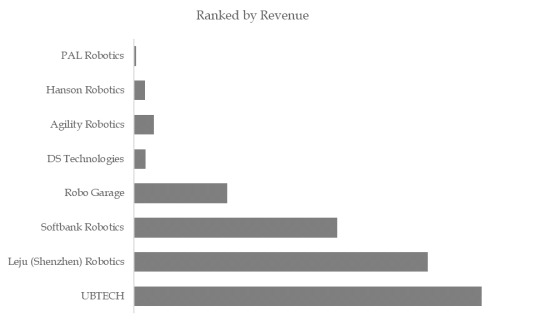
Based on or includes research from QYResearch: Global Biped Robot Market Report 2023-2029.
Globally, the major manufacturers of bipedal robots include UBTECH, Leju, SoftBank Robotics, Robo Garage, DS Technologies, Agility Robotics, Hanson Robotics and PAL Robotics, among which the top five manufacturers account for approximately 65% of the market share.
At present, the world's core commercial manufacturers are mainly distributed in China and the United States. Among them, Chinese companies Youbixuan and Leju mainly focus on small bipedal robots, while large-scale robot companies that have not commercialized include Xiaomi and Unitree Robotics; foreign companies include Boston Dynamics, Honda, Toyota, Tesla, Sanctuary AI, 1X Technologies and Figure AI, etc.
Figure. Biped Robot, Global Market Size, Split by Product Segment
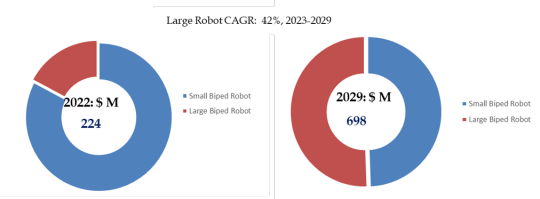

Based on or includes research from QYResearch: Global Biped Robot Market Report 2023-2029.
In terms of product types, small biped robots are currently the most important subdivided product, accounting for about 80% of the market in 2022. From the perspective of product type and technology, small bipedal robots occupy a large market share due to their low manufacturing cost and high degree of commercialization. Most of them are used in education and entertainment fields. Large-scale bipedal robots are costly and difficult to produce, and their selling prices are quite different from small ones. Currently, due to cost and technical issues, terminal applications are relatively limited. Although enterprises can produce them, their commercialization is not high. With the development of future technology, AI and deep learning technology will become more mature, and large-scale bipedal robots are expected to be controlled on the cost side, thereby achieving large-scale production and sales. It is estimated that by 2029, the market size of large biped robots is expected to dominate, and the CAGR 2023-2029 will reach 42%.
Figure. Biped Robot, Global Market Size, Split by Application Segment
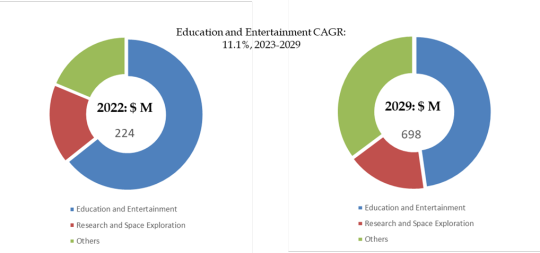
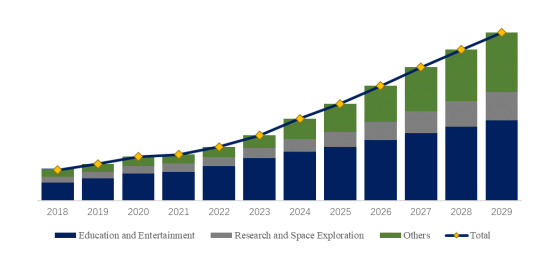
Based on or includes research from QYResearch: Global Biped Robot Market Report 2023-2029.
In terms of product applications, education and entertainment are currently the main sources of demand, accounting for approximately 65% of the market share in 2022. Humanoid robots (wheeled and bipedal) are robots designed and manufactured to imitate human form and behavior. They have a human-like appearance, can adapt to human living and working environments, replace or assist humans in completing various tasks, and can It expands human capabilities in many aspects and has broad application prospects in services, medical care, education, entertainment and other fields. Among them, wheeled humanoid robots are more widely used than bipedal robots because of their simple structure and convenient control.
Bipedal robots are currently mainly used in education, entertainment, research and space exploration, and a small number of them are used in the medical and logistics fields.
Figure. Biped Robot, Global Market Size, Split by Region (Production)
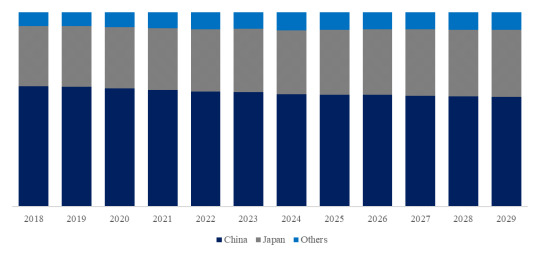

Based on or includes research from QYResearch: Global Biped Robot Market Report 2023-2029.
As far as the production side is concerned, currently commercialized bipedal robots are mainly produced in China and Japan, and other regions are mainly the United States and Europe. Among them, China's output accounts for a large share, reaching 59% in 2022; followed by Japan, accounting for 32%. In the past two years, Chinese, American, Canadian and European companies have continuously poured into the bipedal robot market and launched new products. For example, China: Xiaomi’s CyberOne, Unitree’s Unitree H1, the United States: Tesla’s Optimus, Figure AI’s Figure 01, Canada: Sanctuary AI’s Phoenix, etc. In the future, the share of North American and European countries is expected to exceed 10%.
Figure. Biped Robot, Global Market Size, Split by Region
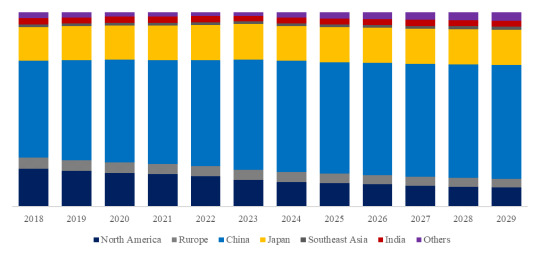
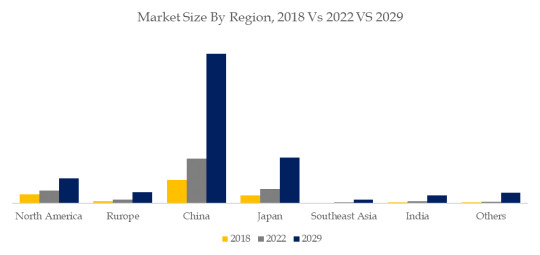
Based on or includes research from QYResearch: Global Biped Robot Market Report 2023-2029.
As far as the consumption area is concerned, it is currently mainly North America, Europe, China, Japan, India and Southeast Asia. Among them, China, Japan and North America have a market share of more than 85%. With the development of China's robot industry, the volume of the robot market will continue to expand, which is expected to improve the biped robot industry technology and reduce costs. It is estimated that by 2029, China's biped robot market share will reach 60%.
About The Authors
Junping Yang - Lead Author
Email: [email protected]
Junping Yang is a technology & market senior analyst specializing in semiconductor devices, materials, and equipment. Yang has 9 years’ experience in semiconductor and focuses on ICs, semiconductor materials, package & testing, power semiconductor (IGBT, SiC, diode, MOSFET, modules and discrete), compound semiconductor (SiC, GaN, etc.), power, RF, optoelectronics, ceramic substrates (HTCC, LTCC, DBC, AMB, DPC, DBA), CMP, equipment & parts (wafer transfer robot, EFEM/Sorter, heaters, etc.). He is engaged in the development of technology and market reports and is also involved in custom projects.
About QYResearch
QYResearch founded in California, USA in 2007.It is a leading global market research and consulting company. With over 16 years’ experience and professional research team in various cities over the world QY Research focuses on management consulting, database and seminar services, IPO consulting, industry chain research and customized research to help our clients in providing non-linear revenue model and make them successful. We are globally recognized for our expansive portfolio of services, good corporate citizenship, and our strong commitment to sustainability. Up to now, we have cooperated with more than 60,000 clients across five continents. Let’s work closely with you and build a bold and better future.
QYResearch is a world-renowned large-scale consulting company. The industry covers various high-tech industry chain market segments, spanning the semiconductor industry chain (semiconductor equipment and parts, semiconductor materials, ICs, Foundry, packaging and testing, discrete devices, sensors, optoelectronic devices), photovoltaic industry chain (equipment, cells, modules, auxiliary material brackets, inverters, power station terminals), new energy automobile industry chain (batteries and materials, auto parts, batteries, motors, electronic control, automotive semiconductors, etc.), communication industry chain (communication system equipment, terminal equipment, electronic components, RF front-end, optical modules, 4G/5G/6G, broadband, IoT, digital economy, AI), advanced materials industry Chain (metal materials, polymer materials, ceramic materials, nano materials, etc.), machinery manufacturing industry chain (CNC machine tools, construction machinery, electrical machinery, 3C automation, industrial robots, lasers, industrial control, drones), food, beverages and pharmaceuticals, medical equipment, agriculture, etc.
0 notes
Text
Global Service Robotics Market Report: Industry Size, Share, Statistics, Companies, and Growth Analysis - 2028
The global service robotics industry has been witnessing remarkable growth in recent years, driven by advancements in technology, increasing demand for automation across various sectors, and a growing need for innovative solutions to address complex challenges.
Global Service Robotics Market Size and Share:
The service robotics industry has experienced substantial expansion, with its size reaching unprecedented levels. According to MarketsandMarkets latest market research report, the global service robotics market size is projected to reach USD 84.8 billion by 2028 from USD 41.5 billion in 2023; it is expected to grow at a CAGR of 15.4% from 2023 to 2028.
The professional service robots are expected to hold a larger service robotics market share as compared to domestic service robots during the forecast period. The service robots used for professional applications include drones, agricultural robots, inspection robots, humanoid robots, exoskeletons, construction robots, unmanned surface vehicles (USVs), and autonomous underwater vehicles (AUVs) among others.
Service robotics market in North America to hold largest market share during the forecast period.
The factors driving the market in North America include the high per capita income, ongoing research programs, increasing aging population, and shortage of labor due to stringent immigration laws.
Mexico is still a developing country, and many service robots have not penetrated Mexico due to their high cost. Mexico can offer a good opportunity for service robots owing to a strong agriculture industry and various free trade agreements signed by the country. The following table lists some of the players operating in this region.
Download PDF Brochure: https://www.marketsandmarkets.com/pdfdownloadNew.asp?id=681
Service Robotics Market Statistics and Trends:
The global service robotics market Report provides insightful statistical data on market trends, industry growth patterns, and new technologies. To improve the capabilities of service robots and broaden their applications, robotics companies are progressively integrating artificial intelligence (AI), machine learning, and other cutting-edge technology into their products.
Service Robotics Market Growth Analysis
Growing adoption of robots for new applications, surging use of IoT in robots for cost-effective predictive maintenance, and increasing use of disinfection robots due to rising cases of hospital-acquired infections (HAIs) are driving the growth of the service robotics industry. Robots are increasingly being adopted for new applications due to advantages such as increased productivity, streamlined processes, and greater workplace safety.
Major Companies in Service Robotics Market
The global service robotics market boasts a competitive landscape, with several prominent companies contributing to its growth. Key market players include iRobot (US), Intuitive Surgical (US), Daifuku (Japan), Samsung Electronics Co. Ltd. (South Korea), JD.com Inc. (China), DeLaval (Sweden), DJI (China), Kongsberg Maritime (Norway), Northrop Grumman (US), Neato Robotics (US), KUKA (Germany), Lely (Netherlands), ECA Group (France), 3DR (US), Stryker Corporation (US), HARVEST CROO (US), Starship Technologies (US), PARROT SA (France), General Electric (US), Amazon Robotics (US), Diligent(US), AMP Robotics (US), UVD Robots (Denmark), XAG (China), and Exyn Technologies (US).
#service robotics market#Service Robotics Market Report#Service Robotics Industry#Global Service Robotics Market#Service Robotics Market Share#Service Robotics Market Size#Service Robotics Companies#Service Robotics Market Growth#Service Robotics Market Statistics
0 notes
Text
Educational Robots Market Surpasses US$ 4.1 Billion in 2027: An In-Depth Analysis
The market for educational robots is expected to be worth US$ 5.0 billion by 2032. It was 1.1 billion in 2022. According to Future Market Insights, the market would exhibit a CAGR of 16.3% from 2022 to 2032. A 20.0% CAGR was seen in the market from 2017 to 2021.
The Popularity of educational robots, which is on the rise, can be linked to expansion. They aid in establishing an engaging learning environment for students. They enable them to work on problems from the actual world as well.
The Development of pupils’ interpersonal, communication, and problem-solving abilities depends on these robots. The market for educational robots is hence expected to change during the following 10 years.
To Get a Sample Copy of the Report Visit https://www.futuremarketinsights.com/reports/sample/rep-gb-7308
These robots are being used more frequently in colleges, public schools, and special education facilities. Ongoing technical improvement and widespread use of e-learning platforms are further boosting market expansion.
Sales would increase as the number of companies making educational robots surged. Government and non-government groups are expanding their investments, thereby creating more opportunities. By 2032, these reasons would increase in educational robots demand.
Blue Frog Robotics & Buddy recently bagged a 1,750 robot order from the French Ministry of National Education for usage in 2022. These robots will help pupils who are housebound or in hospitals to communicate with their classmates in schools from a distance.
Robotic applications are rapidly becoming commonplace in educational settings. Few schools are currently experimenting with teaching robots to better educate their students.
These robots can be used to teach subjects such as science, technology, engineering, and math. These are essential to the educational curriculum.
Robots can also help millennials who work as teachers or children who attend homeschooling. They are perfect in these circumstances where there is a lack of human competence.
Key Takeaways from Educational Robots Market Study
North America would lead the educational robots market and reach a valuation of US$ 2.01 billion by 2032.
The USA educational robots market size would reach US$ 1.6 billion by 2032.
By application, the higher education segment would exhibit a CAGR of 1% from 2022 to 2032.
The non-humanoid type of educational robot would lead and flourish at a CAGR of 2% from 2022 to 2032.
China educational robots market would exhibit steady growth at a CAGR of 3% from 2022 to 2032.
“Children’s collaboration and social connections can be improved with the aid of robots. Robotics in schools is hence ideal for fostering engagement in learning environments. Studying with or interacting with robots can be beneficial for students with disabilities as well.” – Says a lead analyst.
Ask an Analyst for More Details https://www.futuremarketinsights.com/ask-the-analyst/rep-gb-7308
Competitive Landscape: Educational Robots Market
The market for educational robots is stable thanks to the presence of numerous illustrious companies. They would engage in acquisitions and mergers to gain an edge over their rivals. Other businesses are concentrating on joint ventures, alliances, and new product launches.
For instance,
In June 2021, Hanson Robotics announced that they are creating a robot called Grace. It will be used for interacting with people isolated by the COVID-19 pandemic. The robot can talk with patients and show emotions. It is dressed in the blue uniform of a nurse. It is equipped with a camera. It is used to measure patients’ responsiveness, temperature, and measures. Grace can initiate talk therapy, take readings, and help healthcare providers in the hospital. It can express thoughts similar to a human being. It will be used in the healthcare industry for research purposes.
In June 2020, OrangeApps GmbH started making educational robots for KUKA Robotics and other industry players. OrangeApps GmbH develops individual software solutions for robotic systems. These robots are programmed similarly to those of KR Quantec from KUKA Robotics. These robots are used in colleges and universities by students to get hands-on experiences.
Key Companies Profiled: Aisoy Robotics, Hanson Robotics Limited, Modular Robotics, PAL Robotics, Probiotics America
Get More Exclusive Insights into Educational Robots Market Study
Future Market Insights, in its new offering, presents an unbiased analysis of the educational robots market, presenting historical market data (2017 to 2021) and forecast statistics for the period of 2022 to 2032.
The study reveals extensive growth in the educational robot market in terms of type (humanoid, non-humanoid), application (primary education, secondary education, higher education), and region
Get More Information on this Report https://www.futuremarketinsights.com/reports/educational-robots-market
Educational Robots Market Outlook by Category
By Type:
Humanoid
Non-Humanoid
By Application:
Primary Education
Secondary Education
Higher Education
Others
By Region:
North America
Europe
Asia Pacific
Latin America
Middle East & Africa
0 notes
Text
Global Robotic Toys Market Size, Trends and Growth opportunity, By Type (Wheeled Robot, Humanoid Robot, Others), By Applications (Children, Adults), Regional Outlook, Competitive Market Share & Forecast, 2023 – 2030.
Global Robotic Toys Market
The Global Robotic Toys Market was valued at USD 5,173.40 million in 2022 and is expected to reach USD 2,05,001.00 million by 2030 at a CAGR of 50.29% from 2023-2030.
Robots combine sensors, computation, and motors to interact smartly & intelligently with their environment. Robotic toys need to be so cheap and robust that they can be used as playthings. The purpose of a robot toy is that, it has specific skills designed to give kids who need it a little extra help in areas in which they might be struggling or lacking. But they can also simply provide a fun and tech-forward way for young generation to learn basic skills through play.
Request Sample Link :https://analyticalmr.com/request-sample/Global-Robotic-Toys-Market/request-sample
Market Drivers
The educational industry continues to grow speedily with changing student needs. Incorporating advanced equipment in teaching classroom has become a requirement for educational institutes in the modern world to attain optimum results. This has conveyed autonomous robot toys into the spotlight. The major market players, leading companies, continuously develop autonomous robot toys that deliver better interactive and practical learning experience. They are adding new technologies in these robotic toys to make them more user-friendly and efficient. Rapid technical development has made it possible to create sophisticated and cutting-edge robot toys in the robotics sector. These toys have features including gesture control, voice recognition, and facial recognition. As a result, consumers are looking for more engaging and interesting toys, which has raised demand for robot toys.
Another element boosting the demand for robot toys is consumers' rising disposable income. Consumers are more likely to buy more expensive toys, including robot toys, as disposable incomes rise. Therefore, increasing demand of autonomous robot toys in educational industry is expected to drive the market growth rate.
Market Restraints
During the forecasted period, high initial costs and high maintenance costs are anticipated to act as some of the major market growth restraints, while a lack of public awareness of the technology behind autonomous robot toys could impede market expansion. The market for robot toys is not standardised, which makes it challenging to create a global product. This is so that consumers can better understand the features and advantages of a given product. This is since various manufacturers employ various components and technology.
Robot toys have a short lifespan since both technology and customer preferences are constantly evolving. Due to different laws, such as safety standards, which might make it challenging for manufacturers to enter the market, it is difficult for manufacturers to stay up with the changing trends and produce new goods. Additionally, the creation and marketing of robot toys are subject to various regulations.
Explore more information here: https://analyticalmr.com/reports-details/Global-Robotic-Toys-Market
Impact Of COVID-19 On Market
The COVID-19 pandemic, that began in China and spread throughout the world, and has had an impact on the autonomous robot toys market. This problem has impacted most autonomous robot toys makers, and it is projected to have a medium-term impact. This is mostly due to the temporary shutdown of robotics-related institutions, universities, and training institutes. It is anticipated that this issue would have a medium-term impact on most manufacturers of autonomous robot toys. This is mainly because colleges and training facilities that deal with robotics have temporarily stopped down. Participants in the market have noticed a decline in sales as a result.
With only a 3% reduction from Q3 2022 to Q3 2022, the situation did improve in Q3 2022. Due to COVID-19, the market experienced tremendous growth among high- and middle-income consumers, inspiring the big companies to develop several stay-at-home product lines. During the epidemic, online retail of products dominated toy and game sales. However, the market is expected to recover in the coming years, as parents will be more likely to purchase toys for their children to cope with the pandemic. Furthermore, the increasing popularity of online shopping and the increasing use of robots in the home is expected to drive the growth of the market. Additionally, the increasing trend of using robots in education and entertainment is expected to drive the growth of the market.
Impact of Russia-Ukraine Conflict on Global Robotic Toys Market
Negative impacts are globally foreseen, especially across Eastern Europe, European Union, Eastern & Central Asia, and the United States. This contention has severely affected people's lives and livelihoods and represents far-reaching disruptions in trade dynamics. The war between these two countries has led to economic sanctions on multiple countries, surge in commodity prices, and supply chain disruptions, effecting many markets across the globe. The potential effect of the war had, adverse impact on the market of Global Robot Toys Market.
Post war affects toys have helped Ukraine – Russia Kids to process War Trauma. The Russia-Ukraine war has the potential to exacerbate supply chain issues and the raw material shortage that has impacted the industry for the past two years. The most immediate risk is to the supply of specific raw materials used in robotic Toys manufacturing such as neon and palladium.
Market Segmentation
The Global Robotic Toys Market is segmented into Type, and Applications.
Based on Applications, the Children segment accounted for largest revenue share of million 3,024.75 in the year 2022, followed by Adults segment with value of 2,148.65 in the year 2022.
Regional Analysis
The Global Robotic Toys Market is segmented into five regions such as North America, Latin America, Europe, Asia Pacific, and Middle East & Africa.
Based on region, North America held the largest share in 2022 and it is expected to account for the highest CAGR of the Robot Toys Market by 2030. The U.S. is expected to contribute higher value in the North American Robot Toys Market through 2022, owing to the high adoption rate of autonomous robot toys in educational institutes and to the rapid advancements in science in this region.
Key Players
Various key players are discussed into the Global Robotic Toys Market Report including: Abilix, Bluefrog Robotics, Fischertechnik, Lego, Modular Robotics, Parallax, Inc., Pitsco, ArcBotics, Robotis, and SoftBank Robotics.
For Instance, in 2018, Quark Software Inc. was acquired by Parallax Capital Partners, LLC (Parallax), a Southern California-based software-focused private equity firm. The new owners intend to help Quark accelerate the adoption of its transformational content automation solutions through investment in organic growth and acquisitions.
Market Taxonomy
By Type
• Wheeled Robot
• Humanoid Robot
• Others
By Application
• Children
• Adults
By Region
• North America
o U.S.
o Canada
o Mexico
• Latin America
o Brazil
o Argentina
o Colombia
o Peru
o Chile
o Venezuela
o Rest of Latin America
• Europe
o Germany
o France
o UK
o Russia
o Italy
o Spain
o Rest of Europe
• Asia Pacific
o China
o Japan
o India
o South Korea
o Australia
o New Zealand
o Singapore
o Malaysia
o Rest of Asia Pacific
• Middle East & Africa
o Saudi Arabia
o UAE
o Egypt
o Kuwait
o South Africa
o Rest Middle East & Africa
"
0 notes
Text
Humanoid Robot Market Size, Worldwide Demand, Growth, Industry Revenue and Business Views is Projected To Reach $609.5 Million By 2031| Growing at a CAGR of 7.7%.
Humanoid Robot Market by Component (Hardware, Software), by Application (Research and Space Exploration, Education and Entertainment, Personal Assistance and Caregiving, Hospitality, Search and Rescue, Others), by Motion Type (Biped, Wheel drive): Global Opportunity Analysis and Industry Forecast, 2022-2031.
The global humanoid robot market was valued at $307.6 million in 2021, and is projected to reach $609.5 million by 2031, growing at a CAGR of 7.7% from 2022 to 2031.
Download Research Report Sample & TOC:
Some of the major key players of the humanoid robot market include,
Toshiba Corporation,
HYULIM ROBOT,
PAL ROBOTICS,
TOYOTA MOTOR CORPORATION,
SoftBank Robotics,
Honda Motor Co. Ltd.,
Trossen Robotics,
Hajime Research Institute, Ltd.,
#semiconductortech#inovasemiconductors#automotiveindustry#datacommunication#semiconductorsolutions#german
0 notes
Text
Humanoid Robot Market| Global Industry Analysis, Market Size, Share, Trends, Analysis, Growth and Forecast, 2023 – 2027
Originally published on Technavio: Humanoid Robot Market by Application, Component, and Geography - Forecast and Analysis 2023-2027
Conducting market research on the Humanoid Robot Market involves analyzing various factors such as market size, trends, key players, applications, and regional dynamics. Here's an outline for a market research report on the Humanoid Robot market:
### Title: Humanoid Robot Market Research Report
#### Executive Summary:
- Brief overview of the Humanoid Robot market.
- Key findings and insights.
- Market trends and growth prospects.
#### Introduction:
- Introduction to the Humanoid Robot market.
- Historical context and evolution of humanoid robotics.
- Purpose and scope of the research.
#### Market Overview:
- Definition and categorization of Humanoid Robots.
- Global market size and growth projections.
- Key segments within the Humanoid Robot market (e.g., industrial, service, entertainment).
#### Industry Trends:
- Current trends shaping the Humanoid Robot market.
- Impact of technological advancements in robotics and artificial intelligence.
- Innovations in humanoid robot applications and capabilities.
#### Key Players:
- Leading companies in the Humanoid Robot market.
- Market share analysis.
- Strategies adopted by major humanoid robot manufacturers and developers.
#### Types of Humanoid Robots:
- Overview of different types of humanoid robots (e.g., industrial robots, social robots, educational robots).
- Market demand for specific types of humanoid robots.
- Applications and benefits of each humanoid robot type.
#### Applications:
- Current and potential applications of Humanoid Robots.
- Impact on manufacturing, healthcare, education, and other industries.
- Case studies highlighting successful humanoid robot implementations.
#### Regional Analysis:
- Regional market trends.
- Key players in different regions.
- Variation in humanoid robot adoption and usage across regions.
#### Technological Landscape:
- Analysis of key technologies driving humanoid robot development.
- Integration with advanced sensors, machine learning, and natural language processing.
- Challenges and opportunities in humanoid robot technology.
#### Market Drivers:
- Factors influencing market growth (e.g., increasing demand for automation, advancements in artificial intelligence, growth of service and companion robots).
- Challenges faced by the industry (e.g., high costs, concerns about job displacement, ethical considerations).
- Opportunities for market expansion.
#### Competitive Landscape:
- Analysis of competition within the Humanoid Robot market.
- Comparative assessment of key players.
- Collaborations and partnerships.
#### Future Outlook:
- Growth projections for the Humanoid Robot market.
- Emerging trends and opportunities.
- Integration with emerging technologies (e.g., 5G, edge computing).
Conclusion:
- Summary of key findings.
- Implications for robot manufacturers, developers, and end-users.
- Recommendations for advancing the adoption of Humanoid Robots in various industries.
To Learn deeper into this report , View Sample PDF
Appendices:
- Technical specifications and data.
- Graphs, charts, and visual representations.
- References and sources.
To Learn deeper into this report , View Sample PDF
This outline provides a comprehensive structure for conducting market research on the Humanoid Robot market. Ensure that you gather data from reliable sources, conduct a thorough analysis, and present your findings in a clear and concise manner.
For more information please contact.
0 notes
Text
⚡🚃Character Information Post!🚃⚡
⚡💜ELEDTRA- ELECTRIC ENGINE. "TWIN" MODEL OF ELECTRA. FREIGHT ENGINE.
Eledtra, a shining and fairly new star on the face of the rails, is built based heavily off of Electra, a pre-existing model, as their company saw better publicity opportunities if they marketed two of their freight runners as twins. Due to this, the two bare striking resemblances. Eledtra stands out with their more silver coloration, thinner hair that glows, and far more reflective/glowing facets than their older counterpart. They are also taller than Electra.
*Note: (My Electra is not present on this blog, not interactable whatsoever, and likely never will be. I like them, but I know if they were on this blog some ppl would prefer them over Eledtra for interactions. They are however still part of the lore and can be mentioned.)
Eledtra is a machine, an ai android of sorts, they are fully sentient and emotional but are still a working robotic machine. They hail from a world in which all rolling stock are humanoid robots. Engines are simply giant robots who can stand at a minimum of 20ft or a maximum of 40ft. Most switchers tend to max out at 27ft. All freight cars and passenger cars are much smaller humanoids ranging from 8-13ft. Brake vehicles like a caboose or brake van stand at around 10-17ft and operate in a similar manner to engines. Rail cranes/Repair Trucks are often in the 22-26ft range due to their size being needed to work on engines.
Eledtra is an any pronouns user, but mainly uses They/He/She, and primarily prefers they/them.
Eledtra, as of now, has been in service for three years, one year less than Electra. They are around 36ft tall. Their eyes are a rather pretty ruby red color, though this does make them a bit of an unsettling sight in the darkness due to their eye-lights and their general body lights glowing so brightly.
Eledtra has four average components: Firecracker: who operates a car that carries explosive substances (name nitroglycerin), Torque: a repair "truck" who travels at the back of the train if accompanying Eledtra, Subzero: who operates a freezer truck, and Killerwatt: Eledtra's security truck who accompanies them in nearly any public space. They can adapt on other freight cars if nessecary.
Eledtra is very much proud of themself, they have a bit of overconfidence and pride themself in being considered a superstar of the railroad. They attend many competitions whenever allowed, and focus intensely on making sure they look good each day. That is not to say they are entirely vain however. They can be standoffish and a little rude to unfamiliar faces, but do their best to be polite and build good relations. Eledtra is intensely protective of and very friendly to those who they are close friends with.
#starlight express#stex#starlight express rp#stex rp#rp blog#roleplay blog#important info#character information post
1 note
·
View note
Text
0 notes